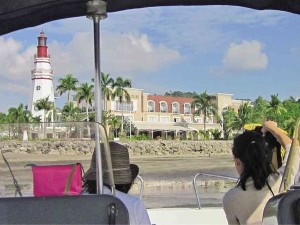
Once a naval base that was the home of the US Seventh Fleet, the Subic Bay Freeport Zone is now a major tourist destination in the country. The fact that it is only a few hours drive from Metro Manila adds to its appeal.
The free port zone encompasses an area of over 67,000 hectares, larger than Singapore, with some 18,000 hectares developed for ecotourism.
The attractions at Subic are many: a virgin forest with seven hidden falls; a jungle survival training camp of the indigenous Aetas; a Bat Kingdom; Tiger Safari; beaches, aquasports, a slew of hotels, resorts and restaurants; a yacht club (for members only); high-end village resorts, malls, duty-free shops, swimming pools and what-have-you—including one (marketing@lighthousesubic.com) which has a real lighthouse.
The above are more or less what the domestic and foreign tourists visit when they go to the Subic Bay Freeport Zone.
What is not generally known is that along the coastal areas of the bay, accessible only by boat, are numerous beach coves which can give A-listed tourist areas like El Nido and Coron in Palawan and Caramoan in Camarines Sur a run for their money.
These coves go by such names as Tago (hidden) Beach, where a forest ranger is assigned; Rock Bottom Beach; and Sunset Cove, which has three beaches. But most of these are uninhabited and, not being islands, are spread out along the coast of Zambales.
These are full of trees, dense in some spots, and different from those species normally found in the province. Forest cover is thick.
One of the leading hotels is The Lighthouse. “The sand is white but it is not fine,” observed Zed Avecilla, front office manager of the Lighthouse Marina Resort. “Sobrang malaking butil (the grains are very large).”
Plain view
And so off we went to check out some of the coves, in a speedboat manned by Zed.
Along the way we saw two resorts, one of them owned by businessman Tonyboy
Cojuangco, but these were not “hidden,” for they were in plain view, accessible by land and sea and presumably had their own clientele.
We could also see Grande Island, a well-known tourist destination, and Capones Island, once like Corregidor a stronghold of the US navy. Parts of Capones have become unsightly, as
documented by Zed, vandalized and littered with trash. Storms have also brought debris to the shore. And Grande Island itself is said to be not as well-maintained as before.
Soon we could see Tago Beach from a distance, and then we linked up with a yacht being used by the hotelier’s friends, some of them UP Mountaineers’ Club members and also surfers and kayakers. The speedboat approached a scenic, uninhabited and apparently nameless island.
There was a well-maintained forest, limestone cliffs and a wide expanse of white-sand beach. The waters became shallow, filled with corals, so the boat had to anchor at a certain distance.
Some surfed, kayaked, swam or just lazed around, enjoying the tropical scenery and seascape.
And there was a lunchbox provided by the resort, delicious adobo and rice.
One boathand was bitten by a seahorse on one knee, and there was a little blood. “Ihian mo (urinate over it),” Zed suggested. That, after all, was the cure for this kind of wound. And the fellow did just that.
Zed and other resort officials have documented at least eight of these coastal beach coves, and have initiated talks with the Subic Bay Metropolitan Authority (SBMA) with a view to promoting these.
“We must promote, preserve and protect these coves,” the hotel manager said. “It’s time for something new in Subic. We must also educate the tourists, the fishermen. We must educate the people and in the process help the locals, the community. We don’t want what happened to Capones Island to happen here.”